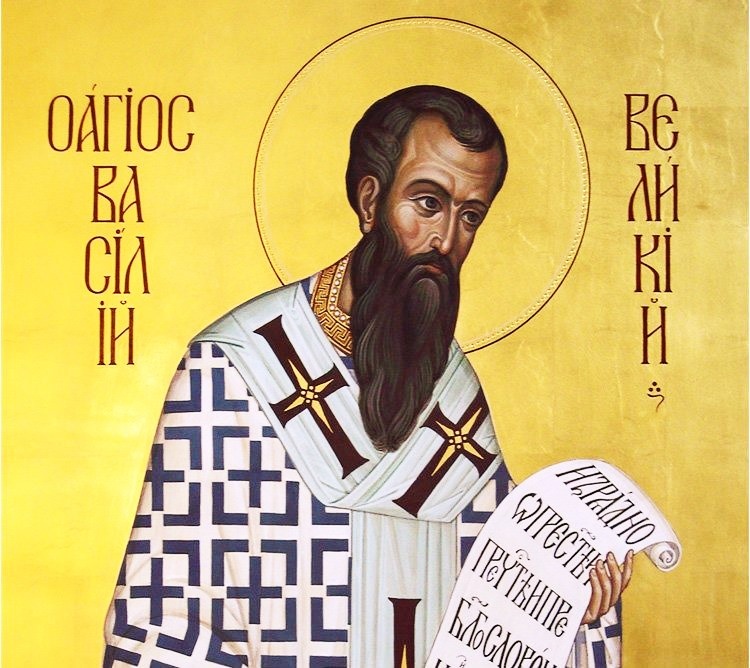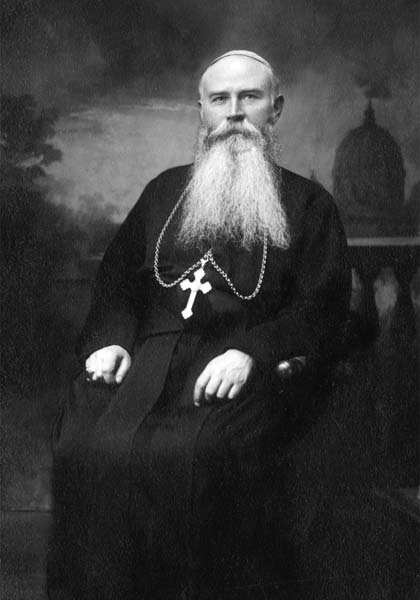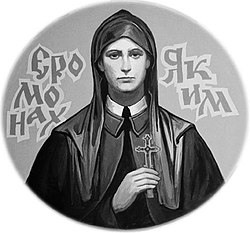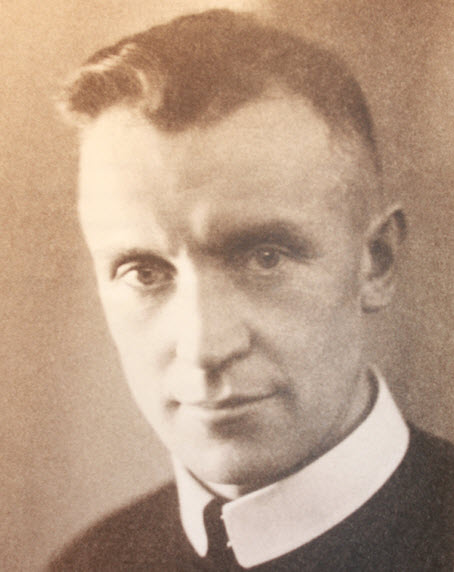SAINTS AND BLESSEDS
SAINT BASIL THE GREAT
Basil the Great (Greek: Megas Basielos), Saint Basil (329 – 379) – saint, archbishop of Caesaria Cappadocia in Asia Minor, eminent ecclesiastical figure, one of the Fathers of the Church and one of the most respected saints in Kyivan Rus.

The French author, Jean Rivier wrote in the book “Saint Basil – Bishop of Caesaria”: “St. Basil is one of the most brilliant and famous figures of the early Greek Church. His contemporaries already called him Great … His rules became the code of monastic life in the East, as the rules of St. Benedict did in the West … He was an ascetic, bishop, interlocutor, teacher, theologian and scholar. Without the least doubt, is the most perfect representative of the Church of his time … The life of St. Basil is consistent with his teachings. In other words, his teachings were a reflection of his life.” Therefore, it is not surprising he deserved the title of Great that the Church bestowed on him. He was great chiefly in three areas of his life: He was the Great Archpastor of the Church, the Great Lawgiver of the monastic life and Great in his sanctity.
Basil was born around the year 330 in Caesaria, the administrative centre of Cappadocia. He came from a well-known family which had a reputation for knowledge and wealth, as well as for the confessing of the Christian faith. His grandfather and grandmother had to hide in the forests of Pontus for seven years during the persecution of Diocletian. Emilia, the mother of Basil, was the daughter of a martyr. Basil’s father, also named Basil, was a lawyer and eminent teacher of rhetoric.
There were ten children in Basil’s family, five sons and five daughters. Five of them were later counted among the saints: his sister Macrina became an example of the ascetic life for him and started one of the first women’s communities of monastic life in Asia Minor. She became superior of women’s monastic communities, which became known as Basilian. One of Basil’s brothers – Gregory, became bishop of Nyssa and an eminent theologian. The first years of St. Basil’s life were on his family’s estate on the Iris river, where he was raised under the direction of his mother and of his grandmother Macrina, highly educated women, who remembered the story of the eminent Bishop of Cappadocia – Gregory.
Basil obtained his elementary education under the direction of his father. Later, he studied under the better teachers in Caesaria Cappadocia, where he got to know Saint Gregory the Theologian. Later he went to school in Constantinople where he audited prominent orators and philosophers. To complete his education, Saint Basil went to Athens, the centre of classical education. After four or five years in Athens, Basil the Great had mastered all the branches of knowledge of the time: philosophy, philology, oratory, law, natural sciences. He had deep knowledge of astronomy, mathematics and medicine. In Athens, the greatest friendship arose between Basil the Great and Gregory the Theologian, and it was life long. Later on, in a eulogy for Basil the Great, Gregory the Theologian enthusiastically spoke of this time: “We were guided by the same hopes, projects, and education … We knew of two paths: one to our priestly temples and to those teachers; the other to the masters of external sciences.”
Around the year 357, Saint Basil returned to Caesaria, where he taught rhetoric for some time. But not long after, after refusing subsequent propositions, Saint Basil entered onto the path of the ascetic life, having accepted baptism from the bishop of Caesaria, Dionisius. Then he traveled to Egypt, Syria, and Palestine, to visit the great Christian ascetics of monastic life. Returning to Cappadocia, he decided to imitate them.
After distributing his property to the poor, St. Basil settled near his sister Macrina on the banks of the Iris River, gathering monks around him. Through his letters, St. Basil the Great attracted his friend Gregory the Theologian to the desert. Saints Basil and Gregory practiced strict austerity: their roofless dwelling had no fireplace, food was scarce, and they worked hard. Basil the Great wore only a shirt and a mantle; he wore his hairshirt only at night so that it would not be visible. In seclusion, Saints Basil and Gregory were intensely engaged in the study of the Holy Scriptures. At the same time, St. Basil the Great, at the request of the monks, wrote a collection of rules for the moral life. By his example and sermons, he contributed to the spiritual improvement of the Christians of Cappadocia and Pontus. As a result, monasteries for men and women were founded.
SAINT JOSAPHAT KUNCEVYCH
St. Josaphat Kuntsevych (secular name Ivan; 1580-1623) was a Ukrainian church leader, and the Greek Catholic Archbishop of Polotsk.

He was born in the city of Volodymyr in what is now Ukraine. In 1604 he entered the Basilian monastery of the Holy Trinity in Wilno (now Vilnius, Lithuania). In 1607, Josaphat Kuncevych, together with Joseph Veliamyn Rutsky, began to reorganize monastic life. In 1609 he became a priest, and in 1613 an archimandrite. In 1618 he became the Greek Catholic Archbishop of Polotsk. Through his writings and sermons, St. Josaphat contributed to raising the educational level of the clergy and deepening the religious fervour of the population.
St. Josaphat’s piety encouraged discipline and monastic spirit, contributing to the rapid spread of Basilian monasticism. His life as a monk and later as a bishop was spent in prayer and preaching. The source of the saint’s deep spirituality was his liturgical life, from which he drew strength and inspiration for his apostolic ministry. The active work of the Archbishop of Polotsk, aimed at the development of the Greek Catholic (Uniate) Church, caused discontent among the opponents.
He is the author of a number of polemical works: “On the Forgery of Slovenian Letters,” “On the Seniority of St. Peter,” “On the Baptism of Volodymyr,” “Catechesis,” and others. St. Josaphat’s desire was to unite all Christians, so he constantly prayed: “Lord, grant us unity!”
St. Josaphat sacrificed his life for the unity of Christians. He was martyred in 1623. In 1642 he was declared Blessed by Pope Urban VIII, and in 1867 he became a Saint of the Catholic Church, after being canonized by Pope Pius IX.
BLESSED JOSAPHAT KOTSYLOVSKY
Josaphat Kotsylovsky was born on March 3, 1876, in the Lemko village of Pakoszówka (present-day Poland). He completed his theological studies in 1907 in Rome. He received two academic degrees: In 1903 he became a doctor of philosophy, and in 1907 he received a doctorate in theology from the Pontifical University of St. Thomas. He mastered Latin and three languages – German, Italian, and French. After receiving his degree, he was ordained to the Priesthood. Soon after, he was appointed vice rector and professor of theology at the Theological Seminary in Stanislaviv.

On October 2, 1911, he entered the novitiate of the Basilian Order. For three years, he served as a teacher in the Basilian houses of studies in Lavriv and Lviv. He also taught during the First World War. Because of a Russian offensive, he was evacuated to Austria. He lived first in Vienna, then organized an emigre seminary in Kromerizh in Moravia and became rector there. On September 23, 1917, in Przemysl, he was ordained a priest by Metropolitan Andrey Sheptytsky. In September 1945, he was imprisoned by Soviet authorities with the goal of liquidating the Ukrainian Greek Catholic Church. Bishop Kotsylovsky was transported from one prison to another and accused of anti-Soviet activities. In those difficult conditions, the bishop contracted pneumonia and was thrown into a concentration camp in the village of Chapaivka, near Kyiv.
Everyone who remembered Bishop Kotsylovsky noted the great humanity and humility with which he performed the most difficult work and tried to alleviate the unbearable living conditions of others. Before the feast of the holy martyr Josaphat, Bishop Josaphat held personal retreats for several days, feeling intimations of his death. He died as a martyr for his faith on November 17, 1947.
Subsequently, priests from the cities of Rudok and Stryi secretly reburied the bishop’s remains at Lychakiv Cemetery in Lviv in a Polish grave. At the present time, the relics of the bishop are in the Church of the Annunciation of the Most Holy Mother of God in Stryi.
On April 12, 2001, in the presence of Pope John Paul II, a decree of martyrdom for Josaphat Kotsylovsky was proclaimed in the Vatican. The rite of beatification took place on June 27, 2001, in Lviv during a Byzantine rite divine liturgy with the participation of Pope John Paul II.
BLESSED PAVEL GOYDYCH
Pavel Goydich was born on July 17, 1888, in the village of Ruski Peklyany, near Presov (present day Slovakia). After hearing God’s call to the priesthood, he entered the theological seminary in Presov. The superiors, seeing his abilities, sent him to university in Budapest for higher studies. On August 27, 1911, together with his older brother Cornel, he was ordained to the Priesthood.

As a talented and pious priest, he was engaged in the education of young people, pastoral care, and work in the bishop’s office. However, he was drawn to the humble monastic life. On July 20, 1922, he entered the monastery of the Basilian Fathers on Chernecha Hora, near Mukachevo. On March 10, 1924, he took his first monastic vows. Immediately after taking his vows, the superiors appointed him confessor of the boys’ boarding school in Uzhhorod and entrusted him with the supervision of the monastery in Malyi Bereznyi. In addition to this, he was entrusted with the task of leading missions among the flock in Zakarpattia and eastern Slovakia. Even before he took his solemn vows, on September 27, 1926, the Apostolic See appointed Fr. Paul as administrator of the Diocese of Presov. In the same year, on the feast of St. Josaphat, he took his lifelong monastic vows in the Krechiv Monastery. On February 19, 1927, Pope Pius XI named him a titular bishop, and then, at the end of 1932, bishop of the Diocese of Presov. Bishop Pavlo Goydych, OSBM, organized various religious societies, missionary and publishing activities, and paid great attention to the intellectual and spiritual training of the clergy.
Bishop Pavlo was characterized by modesty, humility, piety, and extraordinary kindness. In his first pastoral letter, he promised: “I come first of all to you, the poor, to comfort you, to support you, and to help you bear your burden of poverty.” He desired to put an inscription on his bishop’s coat of arms: “God is love – let us love Him!” He realized this motto throughout his episcopal ministry. He visited the sick, poor, and orphans and always gave them a gift. During the Second World War, he freed hundreds of people from concentration camps, defended Jews against persecution, and took care of refugees.
In 1948, Communist authorities occupied the Czechoslovak state and began an intense conflict with the Greek Catholic Church. From that time on, Bishop Paul started on his thorny path. On the night of April 13-14, 1950, the police interned almost all the Greek Catholic clergy in concentration camps, and on April 28, they imprisoned Bishop Pavlo. The secret police took him to an isolated place where he was subjected to sham trials and physical and mental torture. On January 15, 1951, he was sentenced to life imprisonment. The bishop’s way of the cross passed through various prisons in Czechoslovakia. During all that time, no one heard a word of complaint from his lips. Once he said: “I have accepted all suffering willingly, and I am only hurt by what many of my brothers and believers endure because of their faith.” Bishop Pavlo died on July 17, 1960, in Leopoldov prison near Bratislava (present day Slovakia).
Bishop Pavlo Goydych shows us the Gospel of Jesus Christ in practice through his kindness and faithfulness even to the point of death. He was a good shepherd, teacher, and bishop. This monk did not choose the path of wealth and pride of life, like the rich man in the parable, but decided to walk the path of humility and love, the path of goodness. He was a “man with a heart of gold” who became a “father of the orphans and the poor,” a martyr for the faith, and a great admirer of the Blessed Virgin Mary and the Sacred Heart of Christ.
On November 4, 2001, the Holy Father John Paul II proclaimed him blessed in Rome. The Holy Church of Christ honors the memory of Blessed Paul Goydych as a prisoner of Love, a defender of the holy faith, an example of fidelity to his Creator, people and Church.
BLESSED YAKYM SENKIVSKY

Yakym Senkivskyi was born on May 2, 1896, in Haii Velyki near Ternopil (Ukraine) in a large family of peasants of Simon and Antonina. His father was an experienced farmer who skillfully cultivated 25 hectares of arable land, took care of many animals, and kept a large apiary with three hundred hives. It was hard work that required the participation of all family members. Therefore, all the children grew up hardworking, with a sense of duty and respect for people and labor. The father of the future monk, Simon Senkivsky, spared no expense for the education and upbringing of his children, and they were brought up in a Christian and patriotic spirit. Such actions and the father’s position were a good example for his children and family. Therefore, it is understandable that both sons: Ivan (later a hieromonk of the Order of St. Basil the Great, Yakym) and Volodymyr decided to become priests. Ivan Senkivsky completed his theological studies in Lviv and was ordained a priest on December 4, 1921, at St. George’s Cathedral. He continued his theological studies in Innsbruck (Austria), where he received a doctorate in theology.
His righteous soul wanted to follow Christ further. Therefore, on July 10, 1923, he entered the novitiate of the Basilian Fathers in Krekhiv. From the stories of his fellow novices, we learn that he was an exemplary novice monk who, through his life and behavior, was worthy of imitation by others. Everyone admired him for his natural piety, modesty, and hard work. From 1927, Father Professor Yakym Senkivsky worked at the district higher theological school of the Monastery of St. Onufriy in Lavriv. Father Senkivsky was a professor of humanities and rhetoric in Basilian study houses (he taught Ukrainian studies, Latin, general history, geography, and chemistry). After various ministries and monasteries, in 1939 Fr. Yakym was appointed superior of the monastery in Drohobych. From the first days of his stay in Drohobych, he became beloved by the entire city. He was always polite and had a sincere smile on his face. One could feel that there was no malice in this man, and that behind his innate modesty and dignity lay a true servant of Christ.
With the arrival of Father Professor Yakym Senkivsky in Drohobych, pastoral activity quickened, religious life was revitalized by large missions, and parish work was supplemented with innovations. However, this period was marked by the occupation of Galicia by the Soviet authorities, who took away all church property, liquidated monasteries, and forced monks into the street, exiled them, or simply killed them. However, all this did not break the persistent character of the Drohobych monks, and none of the hieromonks left the monastery. Fr. Yakym’s popularity and his sermons, which sowed a deep love for Jesus Christ and the Mother of God in the hearts of the faithful, were a thorn in the side of the Bolsheviks. During his sermons, the church was crowded with believers. With his sermons, Father Yakym was able to keep the people in a constant state of high spirits and hope for a better tomorrow.
Prof. Senkivsky was repeatedly summoned for “conversations” during which he was demanded to stop his pastoral activities in the monastery. But he organized people to remain faithful to the Church with even greater strength and zeal. The enemy could not accept this. On the morning of June 26, 1941, Hieromonk Yakym Senkivsky celebrated the last Holy Liturgy of his life, and before lunch the Bolsheviks arrested him along with Hieromonk Severian Baranyk, the hegumen of the Drohobych Monastery. Several days before, the faithful had urged the fathers to leave the monastery as soon as possible and wait out the danger. Hieromonk Yakym replied: “I will not hide, and without the will of the Lord, not a single hair will fall from my head.”
On June 29, 1941, on Sunday morning, after the Soviet army left the city before the German army entered, the population ran to the court and the adjacent prison in the hope of freeing their relatives, but found only hundreds of tortured bodies. In one of the basement rooms of the court, among other things, a prayer book of Fr. Baranyk and a postcard photo of Fr. Senkivsky were found. However, no one found the body of Hieromonk Yakym Senkivskyy. Eyewitnesses said that he was boiled in a cauldron and given to the prisoners to eat. Hieromonk Yakym Senkivsky remained in the memory of the faithful as the best example of a priest of God who was close to his faithful to the end.
The Blessed Reverend Martyr Yakym Senkivsky was beatified by Pope John Paul II on June 27, 2001.
BLESSED SEVERIAN BARANYK

Severian Baranyk was born on July 18, 1889 in Uhniv, Ukraine. He entered the Order of St. Basil the Great on September 24, 1904, in Krekhiv. After completing his novitiate, he took his first monastic vows there (May 16, 1907) and, on September 21, 1910, solemn vows. He was ordained to the priesthood on February 14, 1915. The first years of his priestly ministry were spent at the Zhovkva Monastery, where he served as a catechist, pastor, and leader of societies for youth and for craftsmen. In addition to this, he was the editor of “The Missionary” and “Our Friend” magazines, and led retreats for consecrated persons and the faithful. Witnesses to his life noted that he was a joyful, sincere, and friendly monk.
In 1932, Hieromonk Severian was appointed superior of the Basilian Monastery in Drohobych and pastor of the church of the Holy Trinity in Drohobych. A great friend of young people, Hieromonk Severian was always interested in sports and was also an energetic public figure. After the occupation of Ukraine by the Soviet army, church and religious life noticeably reduced outwardly, although on the interior level, it became even more authentic. The Soviet authorities forbade Hieromonk Severian to leave the monastery, citing wartime exigencies. The faithful advised the fathers to leave the monastery as soon as possible and wait out the trouble, but the hieromonks did not want to listen to this, answering: “If they don’t find us in the monastery, they may take revenge on you all, so it would be better that we suffer.” They confessed and waited patiently for possible torture. The punitive services (NKVD) took hieromonks Severian Baranyk and Yakym Senkivsky to the Drohobych prison on June 26, 1941. After that, no one saw them alive. One of the witnesses who came to this place recalls: “I saw a large pit behind the prison, which was camouflaged and covered with sand. The pit was fresh, because people were digging it with their hands and pulling out the bodies of the murdered victims. There was a canopy near the pit, and under it I saw the dead body of Father Severian Baranyk, OSBM, which was severely mutilated as a result of torture in prison. My father later told me that a cross was also carved on his chest.” The hieromonk’s burial place is not definitively known, but numerous testimonies indicate that he was buried with others in a common mass grave at the cemetery in Drohobych.
The Blessed Venerable Martyr Severian Baranyk was beatified by Pope John Paul II on June 27, 2001.
BLESSED VITALIY BAIRAK

Vitaliy Bayrak was born on February 24, 1907, in the village of Shvaykivtsi in the Ternopil region of Ukraine. On September 4, 1924, he entered the Order of St. Basil the Great. He was ordained a priest on August 13, 1933. Afterwards, he was a teacher at the St. Josaphat Missionary Institute at the Basilian Fathers’ Monastery in Buchach, where he also served as a confessor and led church groups in the parish at the monastery. In 1935-1941 he was engaged in pastoral work in the parish of the Sacred Heart of Christ at the Zhovkva Monastery. In addition, he was appointed assistant superior and leader of the Marian girls’ group and the Apostolate of Prayer, and traveled to various places in Galicia on popular missions and retreats. From 1941 he was the superior of the Drohobych Monastery.
The grateful faithful respected and loved this affable monk not only for his teachings and his own example, but also for his talent for listening, supporting, giving apt spiritual advice, etc. His love for the Church and his people inspired others.
By the decision of the military tribunal of the communist authorities, he was sentenced to 8 years in prison. His “fault” was that he was a zealous priest, a tireless soldier of Christ. Eyewitnesses say that in prison the monk was severely beaten, and later brought to his cell unconscious. Due to frequent torture, Hieromonk Vitalii died before Easter 1946 in the Drohobych prison “Bryhidky”.
The Blessed Reverend Martyr Vitalii Bayrak was beatified by Pope John Paul II on June 27, 2001.

 Basilian Order of Saint Josaphat
Basilian Order of Saint Josaphat 

